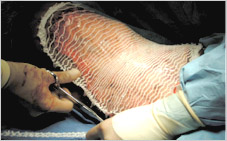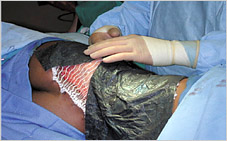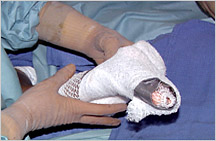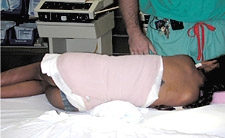Dressings should be built in layers
to protect the INTEGRA® Template site from
shear and infection.
Layer 1.
Sterile elastic net dressing is applied in the OR |
 |
|
Layer 2.
The antimicrobial layer (e.g., moistened Acticoat*
) is applied over the elastic net dressing. The
antimicrobial layer helps prevent bacterial contamination
through seams and staple holes. In meshed INTEGRA®
Template sites, antimicrobials can penetrate down
to the wound bed.
Acticoat*, Sulfamylon Solution
5% or silver nitrate 0.5% are most often applied.
It is important to re-moisten or re-apply antimicrobial
dressings as needed. The antimicrobial layer is
most critical during the first week after application.
|
 |
Layer
3.
A bulky gauze dressing is applied over the antimicrobial
layer to protect the site and to help reduce the potential
for shearing and graft dislodgement. It also helps
keep the antimicrobial dressing moist and in contact
with INTEGRA® Template. |
 |
Layer
4.
A compression layer is applied over the bulky dressing.
The compression wrap provides additional support and
protection. As edema subsides, the wrap should be
re-applied to ensure it is snug. |
 |
*Acticoat is a trademark of Smith & Nephew.